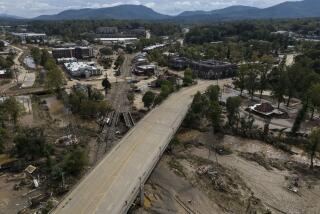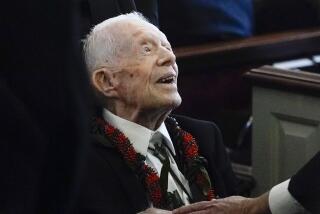Cold War Secrecy Tied to Radiation Peril : Ethics: Closed debate on government’s atomic testing decades ago meant contractors, researchers were unaware of human dangers, report says.
Investigators reviewing the history of government-sponsored atomic experiments concluded Friday that Cold War secrecy and bureaucratic sprawl created a patchwork of policies that unwittingly exposed many humans to potentially dangerous radiation.
In a preliminary report, the Advisory Committee on Human Radiation Experiments found that senior government officials extensively debated the need for human experimentation and the policies that should govern it. But because that debate was often secret, many contractors and university researchers apparently were unaware of legal and ethical concerns surrounding the experiments they were paid to conduct.
In 1954, for example, Secretary of Defense Charles E. Wilson directed that human radiation experiments conducted by the Defense Department should follow the strict code of medical ethics that emerged from the post-war Nuremberg trials. But he classified his directive “top secret,” which meant that it could not be shared with many involved in the programs.
“That’s one of the most intriguing and perplexing problems we came up with,” said Ruth Faden, a medical ethicist from Johns Hopkins University named to lead the 14-member panel. “We are still trying to figure out why anybody in his right mind would adopt an ethical policy and then classify it secret.”
Faden said that her panel, established by Energy Secretary Hazel O’Leary last April, has largely documented the existence of some 400 government-sponsored radiation experiments that exposed humans to radiation between 1947 and 1977. But Faden added that, by the time the huge data-gathering effort is completed, the number of experiments “will probably be in the thousands.”
Among those are hundreds of experiments in which Energy Department contractors intentionally released radiation into the general population to study its effects. That is many times more than the 13 intentional releases the committee had known about earlier, including one in which radiation released from a planned rocket malfunction drifted over Los Angeles.
In spite of appearances, however, committee members said it was clear that the experiments were not conducted in an ethical vacuum. Faden said there were active debates, some involving senior officials, university leaders and leading scientists, about what ethical guidelines should govern the experiments.
Even when guidelines were drafted in the open and made available widely, they apparently were not always carried out in the field. In many cases, scientists seemed unsure which government agency’s policy governed their research.
In other cases, there was confusion over such questions as whether guidelines governing experimentation on normal, healthy adults extended to those who were in institutions or gravely ill.
While the committee found evidence of ethical debates, Faden said, “it would be a mistake to leave the impression . . . that this discussion was a result of ethical soul-searching about whether this was something we ought to be undertaking as a nation.”
Much of the debate that took place in late 1940s and early 1950s “may well have been animated by straightforward legal concerns about liability--we’re not sure about that--but also perhaps about insurance and public relations issues,” Faden said.
Secrecy also has hampered efforts to construct a full picture of the government’s vast apparatus of experimentation.
“Significant collections of relevant material are still classified,” the report said.
The Energy Department, which is being pressed by O’Leary to be more forthcoming on nuclear matters, has said that it must protect much of the documentation on 250 tests in which radioactive lanthanum was intentionally released into the atmosphere by Los Alamos Laboratories in New Mexico.
The Defense Department has similarly refused to declassify information related to a 1949 experiment in which it released radioisotopes into the atmosphere from the Hanford Nuclear Plant in Washington state.
Committee members said that the Central Intelligence Agency also has been reluctant to locate and declassify documents about its participation in the planning of government-sponsored human experiments involving radioactivity.
Only Faden and six of the committee’s staff members have been granted security clearances allowing them to comb through millions of pages of secret documents.
More to Read
Sign up for Essential California
The most important California stories and recommendations in your inbox every morning.
You may occasionally receive promotional content from the Los Angeles Times.











